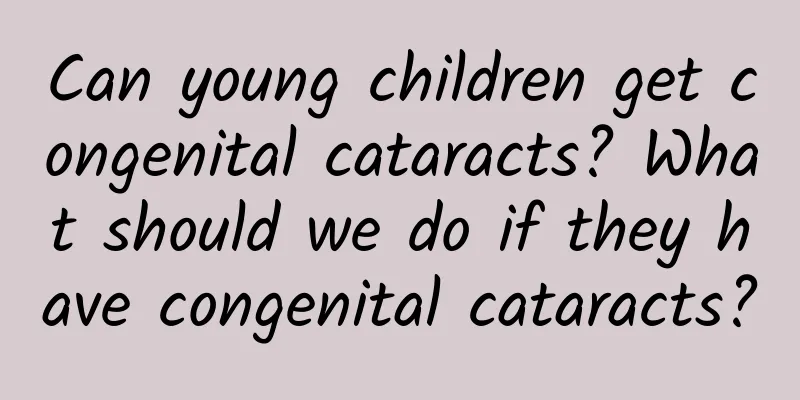Can young children get congenital cataracts? What should we do if they have congenital cataracts?

|
In daily life, we often hear about diseases such as cataracts from others or see them on TV. Many people think that cataracts are an eye disease caused by aging and only occur in some older people. Little do people know that cataracts can be congenital or acquired, that is, some infants or children may also be cataract patients. In fact, congenital cataracts are a common eye disease in children and one of the main causes of blindness in children. The incidence of congenital cataracts worldwide is 0.6/10,000-6/10,000. According to the WHO report, congenital cataracts account for about 10% to 38% of the cases of blindness in children due to various reasons each year. 1. How to preliminarily determine whether a child suffers from congenital cataracts? The main symptom of cataract in infants and young children is leukocoria. The so-called "leukocoria" means that there is a white reflex in the pupil area of the newborn after birth. The most common one is congenital cataract. Incomplete cataracts often cause abnormal eye conditions such as poor vision, strabismus, and nystagmus. Therefore, if infants and young children have these conditions, parents must not ignore them and must go to a regular hospital for treatment in order to determine the condition of the infant and young children, and detect and treat them as soon as possible. 2. What are the causative factors of congenital cataracts? The pathogenesis of congenital cataracts is complex, and about one-third of the causes are related to genetics. There are three inheritance modes of simple congenital cataracts: autosomal dominant inheritance, autosomal recessive inheritance and sex-linked inheritance. Among them, autosomal dominant inheritance (some of which manifest as irregular skipping-generation inheritance) is the most common. Non-hereditary cataracts are lens opacities caused by local or systemic disorders during embryonic development. (1) One of the main causes of cataracts in children is malnutrition and metabolic disorders, such as anemia or calcium deficiency in the mother during pregnancy, malnutrition, vitamin deficiency, hypothyroidism, abnormal delivery, history of asphyxia, hypoxic-ischemic encephalopathy, etc. (2) Environmental factors are also one of the causes of cataracts in infants and young children. For example, viral infections (such as rubella, measles, chickenpox, mumps, etc.), chemicals, X-ray exposure, etc. in the early stages of pregnancy can cause growth disorders in the fetal lens and lead to cataracts. (3) In addition, some newborns inhale hyperbaric oxygen for a long time due to various critical illnesses after birth. 3. What should I do if I find out that I have congenital cataracts? First of all, we should understand that there are huge individual differences in the onset, severity, clinical characteristics and treatment prognosis of congenital cataracts, and infants and young children have unique anatomical and physiological characteristics. Therefore, the international ophthalmology community has not yet reached a consensus on issues such as the surgical indications, timing and methods for children with cataracts. Congenital cataracts can be treated surgically or conservatively, and the key factors in determining whether surgery is necessary are the degree of lens opacity, the location of the opacity, and the condition of the eye. Therefore, it is best to conduct a detailed examination after discovering the problem to clarify the condition of the disease. Although congenital cataracts objectively require cataract removal as soon as possible to restore the transparency of the refractive medium to establish normal visual function. However, the eye structure of infants and young children is still in the development stage, and the blood-aqueous barrier function is not yet perfect. Surgery is prone to cause severe inflammatory reactions and complications such as secondary glaucoma. In addition, the loss of accommodation ability after lens removal increases the risk of amblyopia. In order to avoid and reduce complications, surgery should be postponed. In this regard, ophthalmologists and patients also need to consider multiple aspects comprehensively and weigh the pros and cons to make a decision. Postoperative visual function reconstruction after surgery is another important step in enabling children to eventually achieve good visual outcomes, but it is often overlooked. Visual function reconstruction mainly includes correction of postoperative refractive errors, prevention and treatment of amblyopia, restoration of fusion function and stereoscopic vision, and other measures, thereby maximizing the improvement of the prognosis of children's visual function. Early detection, early prevention: Studies have found that the recovery of vision after congenital cataract surgery depends largely on the time when the cataract is discovered and treatment begins, so the prevention, diagnosis and treatment of congenital cataracts is an important task. Now, with the continuous improvement of surgical methods and surgical techniques, the success rate of congenital cataract surgery has been greatly improved in clinical practice. Article transferred from: Wang Zhiqiang, Director of Ophthalmology, the Third Affiliated Hospital of Beijing University of Chinese Medicine Recommended experts by the Popular Science Health Education Center Expertise: Combining Chinese and Western medicine to treat dry eyes, cataracts, children's eye diseases, and fundus diseases Wang Zhiqiang: Doctor of Medicine, Associate Chief Physician, Director of Ophthalmology. He is also Secretary General of Ophthalmology Branch of Chinese Society of Traditional Chinese Medicine Information, Director of Science Popularization and Health Education Center of China Medical Education Association, Vice President of TCM Hospital Management Branch of Chinese Society of Traditional Chinese Medicine Information, Deputy Secretary General of Ophthalmology Committee of Chinese Medical Doctor Association, Executive Director of Ophthalmology Branch of Chinese Society of Ethnic Medicine, Vice President of Young Physician Branch of China Association for the Promotion of Traditional Chinese Medicine, Member of Ophthalmology Branch of China Association of Traditional Chinese Medicine, Director of Ophthalmology Committee of World Federation of Chinese Medicine Societies, and Beijing Science Popularization Expert. He is good at combining traditional Chinese and western medicine to treat myopia, amblyopia, pediatric blepharospasm, dry eyes, age-related macular degeneration, optic atrophy, glaucoma, menopausal eye diseases and other ophthalmic diseases. He is good at cataract, glaucoma, vitreous cavity injection, tear duct, pterygium, eyelid plastic surgery and other surgeries. In the treatment of eye diseases, he advocates the combination of traditional Chinese and western medicine, giving full play to the advantages of both Chinese and western medicine, in order to help patients to the greatest extent. In clinical practice, he comprehensively uses traditional Chinese and western medicine treatment methods, harmonizes internal and external treatments, and treats both the symptoms and the root causes. He has rich experience in the treatment of many common and difficult ophthalmic diseases such as juvenile myopia, blepharospasm, diabetic retinopathy, age-related macular degeneration, ischemic optic neuropathy, optic atrophy, retinitis pigmentosa, high myopia retinal diseases, thyroid-related eye diseases, orbital inflammatory pseudotumors, etc. He has edited and participated in 3 professional books, undertaken and participated in more than 10 national, provincial and ministerial projects, and published more than 20 papers in professional core journals. He is an expert in setting questions for the National Administration of Traditional Chinese Medicine's regular training examination and professional title examination. He has served as a teacher in the Neijing Teaching and Research Section of the Western Medicine and Chinese Medicine Class of Xiyuan Hospital of the China Academy of Chinese Medical Sciences, a teacher of clinical students at Beijing University of Chinese Medicine and Binzhou Medical College, a teacher of Beijing and district-level continuing education projects, and also teaches ophthalmology graduate students and international students. He is keen on popularizing ophthalmic knowledge and has been invited to participate in the recording of TV and radio popular science programs and publish various popular science articles many times. He won the third prize in the 2017 National Popular Science Competition on behalf of the State Administration of Traditional Chinese Medicine. |
<<: Why is the formaldehyde level not high but the TVOC level high? Formaldehyde removal plants
Recommend
How to exercise to tighten the vagina
Many girls will begin to experience vaginal relax...
A woman dreams of cutting her nails
Daily life includes many various trivial things, ...
What to do if the shoulder straps of a suspender skirt keep slipping
Many girls have small frames and narrow shoulders...
What should women do if they suffer from menstrual diseases?
Women face many disease risks in life because of ...
Diagram of the process of egg cell formation
Before pregnancy. Women produce a substance that ...
Is it okay for women to snore frequently?
Many people think that only men snore, but this i...
Is it okay to wash the newly stuffed sausages after they have grown white hair? How to avoid the stuffed sausages growing white hair?
We all know that sausage is a kind of meat food m...
Steaming, stir-frying, boiling, frying, braising, which is the healthiest cooking method?
The Chinese delicacies presented in the food docu...
Causes and Dietary Treatment of Long-term Leucorrhea with Blood
When we see blood in leucorrhea, we will think th...
What to do if a pregnant woman coughs and has white phlegm
During pregnancy, pregnant women may have reduced...
What to do if a 14-year-old girl gets wet
A woman's body will undergo a series of chang...
How many types of bamboo shoots are there? How to peel bamboo shoots?
One of the types of bamboo shoots is winter bambo...
Is it normal to have breast lumps during pregnancy?
Women's bodies are extremely sensitive during...
Meta: Threads registered over 100 million in just 5 days Twitter's network traffic fell 11% compared to the same period in 2022
Recently, Meta CEO Zuckerberg announced that Thre...
Uterine repositioning technique
I believe that many people do not understand the ...









